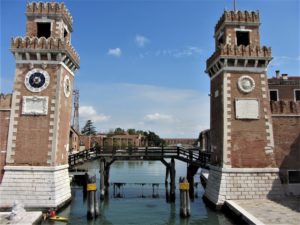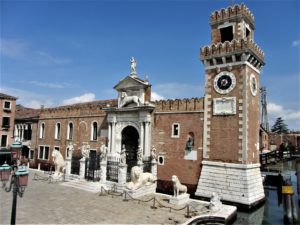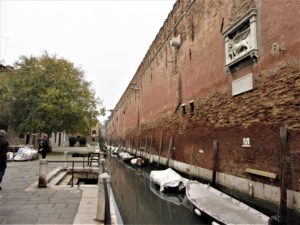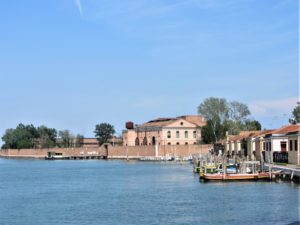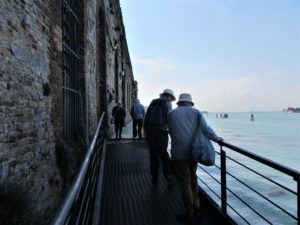Castello is the largest district (sestiere) of Venice and includes the touristy, more wealthy, areas near San Marco in the west and in the east the residential areas where ordinary Venetians live. Walking away from San Marco along the busy Riva degli Schiavoni eventually it gets quieter and the impressive entrance to Arsenale is soon seen on the left, with the Arsenale Canal leading to its imposing main entrance, the Porta Magna, which was built in 1460, possibly designed by Jacopo Bellini. The stone lions near the gate were taken from Greece and placed there in the 17th century.
Construction of the Arsenale began in 1104 and it became the largest industrial complex in Europe before the Industrial Revolution and the symbol of Venetian maritime domination of the Mediterranean. High walls and ramparts were built around the site to both shield the work being carried out from public eyes and for protection. In 1320, a new and larger version of the Arsenale was created which led to the mass production of ships whereby different areas of the shipyard worked on specialised prefabricated ships parts, rigging or armaments; in this way, when needed, a ship could be assembled within a day. By the 16th century the Arsenale was not only used to build and maintain merchant ships but also those of the Venetian navy. Galileo became a consultant to the Arsenale, advising military engineers and instrument makers.
I am always interested in anything to do with social and industrial history and as many of my ancestors were carpenters in the naval dockyards of Chatham and Sheerness in Kent I’d love to see inside this famous facility, however, unless there are exhibits in the Arsenale as part of the Biennale it seems to be impossible to get inside as part of it is still a military base. This year (2022) the Biennale will run from 23 April to 27 November and Arsenale is again one of the sites for the art exhibition so it willprovide a good opportunity to see inside. Day tickets are about 20 Euros but, regardless of the art, I’d be happy to pay that just to see inside the historic dockyard but as we went to Venice last year that is not likely. The central pavilion will be housed in the enormous Corderie (ropery) and there will be installations by South Africa, Peru, Argentina and the UAE in the Sale d’Armi (armaments), originally built in 1460. However, for those not going to the Biennale It’s possible to walk around parts of the outside of the 2 miles of perimeter walls that were built to surround the 110 acres of shipyards. On a family holiday in May 2019 we explored this area by following the wall to the left of the Porta Magna and somehow managed to find our way to a path that stretches the length of the historic buildings on the lagoon side, along an iron walkway and over a bridge that spans the watergate entrance to the Canal de la Galeazze inside the Arsenale. We had wonderful views across to the cemetery island of San Michele and to Murano; we also managed to peer through some windows into a few of the old Arsenale buildings. There is a vaporetto stop called Bacini – Arsenale Nord nearby and I think a ferry ride past this area might give a quick glimpse through the entrance to the canal.
In 2004, despite local opposition, part of Arsenale was leased for 30 years to MOSE, the flood defence project designed to protect Venice from flooding during high tides.
There is a museum of maritime history, Museo Storico Navale which is on the eastern side of the Rio dell’Arsenale. It’s on my list of places to visit but I’ve not yet managed to see inside as for some time it has been undergoing substantial restoration work but hopefully the large collection, including gondolas through the ages, will soon be available for the public to see once again.
